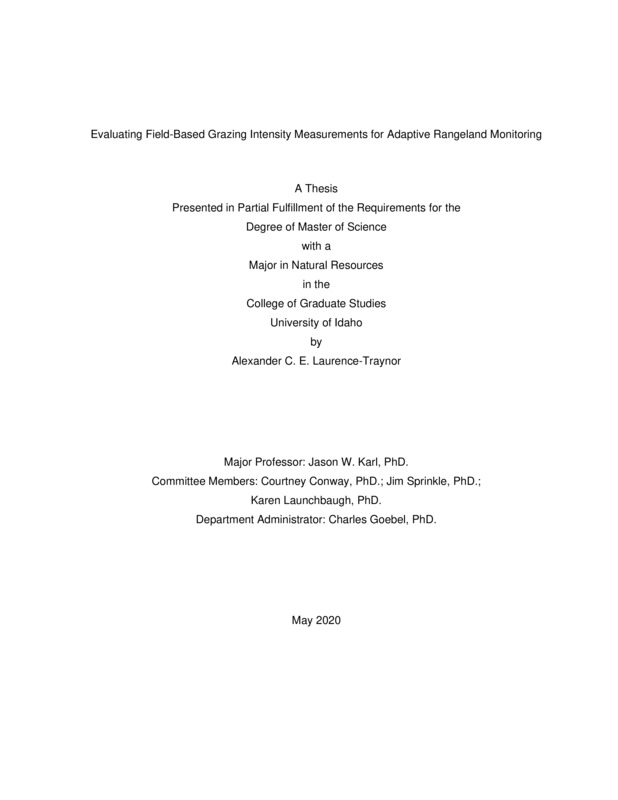Evaluating Field-Based Grazing Intensity Measurements for Adaptive Rangeland Monitoring
LAURENCE-TRAYNOR, ALEXANDER. (2020-05). Evaluating Field-Based Grazing Intensity Measurements for Adaptive Rangeland Monitoring. Theses and Dissertations Collection, University of Idaho Library Digital Collections. https://www.lib.uidaho.edu/digital/etd/items/laurencetraynor_idaho_0089n_11855.html
- Title:
- Evaluating Field-Based Grazing Intensity Measurements for Adaptive Rangeland Monitoring
- Author:
- LAURENCE-TRAYNOR, ALEXANDER
- ORCID:
- 0000-0002-8064-7917
- Date:
- 2020-05
- Keywords:
- bias monitoring rangeland utilization
- Program:
- Natural Resources
- Subject Category:
- Range management
- Abstract:
-
A diversity of field-based grazing intensity measurements are used for rangeland management. However, there is a lack of acknowledgement that the choice of method and their implementation may influence the precision, accuracy and sensitivity of grazing intensity estimates. Improved understanding of the sources of variation and bias within grazing intensity estimates can improve planning of monitoring programs, increase use of more appropriate methods for a given situation, and improve the ability of data to inform management. I evaluated and compared several methods for measuring utilization and grazing intensity in two semi-arid grassland and shrubland ecosystems: the pacific northwest bunchgrass prairie and sagebrush steppe. Utilization methods were also compared to actual stocking rates and locations of livestock using GPS data. A multiple-regression approach used to attribute variation in grazing intensity estimates found a significant proportion of variation was related to observer’s recent experience and training, particularly with visual estimation methods. Other sources of variation in utilization estimates included plant composition and cover. Calibration techniques which used in-field estimates of utilization from quantitative measurements were able to improve the relationship between visual estimation methods and livestock GPS-based grazing intensity estimates. Different methods produced significantly different estimates of mean utilization at both fine and broad scales however correlation between methods and actual stocking rates increased at broader scales. Results suggested improvements to the implementation and design of rangeland monitoring including consideration of observers’ recent experience, increasing site-specific training and using sample designs which represent the fine scale spatial variation in grazing intensity and vegetation cover. Improved understanding of the relative limitations of different rangeland monitoring methods creates capacity to leverage the growing trend in citizen science and provides an opportunity for increased flexibility and resilience in rangeland management.
- Description:
- masters, M.S., Natural Resources -- University of Idaho - College of Graduate Studies, 2020-05
- Major Professor:
- Karl, Jason W
- Committee:
- Conway,, Courtney; Sprinkle, Jim; Launchbaugh, Karen
- Defense Date:
- 2020-05
- Identifier:
- LAURENCETRAYNOR_idaho_0089N_11855
- Type:
- Text
- Format Original:
- Format:
- application/pdf
- Rights:
- In Copyright - Educational Use Permitted. For more information, please contact University of Idaho Library Special Collections and Archives Department at libspec@uidaho.edu.
- Standardized Rights:
- http://rightsstatements.org/vocab/InC-EDU/1.0/

